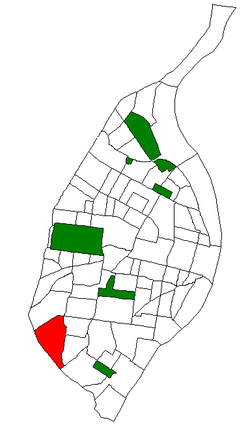St. Louis Hills
| St. Louis Hills | |
|---|---|
| St. Louis neighborhood | |
 Location of St. Louis Hills within St. Louis |
|
| Country | United States |
| State | Missouri |
| City | St. Louis |
| Wards | 12, 16 |
| Area | |
| • Total | 1.63 sq mi (4.2 km2) |
| Population (2010) | |
| • Total | 7,373 |
| • Density | 4,500/sq mi (1,700/km2) |
| ZIP code(s) | Parts of 63110, 63139, 63109 |
| Area code(s) | 314 |
| Website | stlouis-mo.gov |
St. Louis Hills is a neighborhood in St. Louis, Missouri. The neighborhood, which is home to the Chippewa location of Ted Drewes Frozen Custard, is situated in the southwest of St. Louis. It is bounded by Chippewa Street to the northwest and north, Hampton Avenue to the east, Gravois Avenue to the southeast, and the St. Louis county border to the southwest.
St. Louis Hills is rich in its architecture, strategic location, and its history. "Country living in the City" was the phrase used to market St. Louis Hills in the 1930s, since St. Louis Hills was so far west of any other residential or commercial buildings located within the City limits.
The history of St. Louis Hills, developed from 1930-1950s, is relatively recent compared to city's beginnings in 1763. The land which became St. Louis Hills dates back to deeds granted to pioneer French colonists Madame Ann Camp and Anton Reihle in 1768 by one founder of the Village of St. Louis, Pierre Laclède. At the time, the land included 2,471 acres. Camp and Reihl's heirs sold the land to George C. Clarke, who gave it to two sons. When the Village was chartered as the City of St. Louis in 1836, St. Louis Hills was still remote, open and forested land, and essentially remained so until the early 1930s. In 1876, when the county and city of St. Louis separated, the western boundary of St. Louis City was set just west of the River des Peres (River of the Fathers). Even then, what is now St. Louis Hills was still open land.
David Rowland Francis, Governor of the state from 1889-1893, became owner of part of the property in 1884 on which he established his vast farm. At the turn of the century, David R. Francis was President of the Louisiana Purchase Exposition from 1889 until its opening in 1904. Francis originally considered use of his farmland as a site for the World's Fair, but logistics of transportation and construction to Francis' land persuaded use of Forest Park as the now famous 1904 World's Fair site. Francis was appointed U.S. Ambassador to Russia in 1916. The next year, Francis made a gift of the land to the city, and so it was named Francis Park. David Rowland Francis died January 15, 1927.
...
Wikipedia
